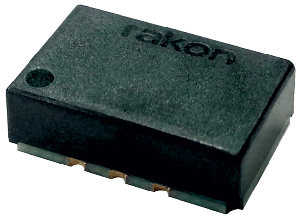Rakon announces the release of its new RHT1490 product series of high frequency and low jitter ultra-stable TCXOs that are available in frequencies from 50 MHz to 204.8 MHz. The RHT1490 delivers world class telecommunications grade stability with a low RMS phase jitter of <200 fs (12 kHz to 20 MHz).
This product platform’s frequency output enables lower system jitter, allowing communication system architects to optimise noise budget and performance.
The RHT1490 is an ideal reference clock solution for SyncE and packet clock requirements (ITU-T G.826x and G.827x). It works with both discrete and integrated IEEE 1588 solutions, providing excellent medium term stability for low loop bandwidth applications. According to Rakon, its ultra-low noise floor performance, combined with system PLL filtering, helps to achieve very low system clock RMS jitter numbers – required by reference clocks of physical layer devices for high speed interfaces (40G and 100G applications).
Key features include:
- RMS phase jitter <200 fs (12 kHz – 20 MHz), typically 165 fs (98.304 MHz output).
- Output frequency: Options from 50 MHz to 204.8 MHz.
- Significantly improved TCXO airflow resistance, reducing transient impact on frequency stability.
- Frequency stability: RHT1490A, <±250 ppb (-40 to 85°C).
- Stratum 3 compliant: RHT1490J, all causes ±4.6 ppm over 20 years.
- Package size: 14.4 mm x 9.2 mm x 4.7 mm max.
- Standard frequencies are available for sampling (others on request): 98.304 MHz, 100 MHz, 122.88 MHz, 125 MHz, 156.25 MHz and 153.6 MHz.
The RHT1490 can also be used in wireless applications; the low close-in phase noise performance (<-120 dBc/Hz @ 1 kHz offset for a 122.88 MHz clock) makes it an ideal candidate for C-RAN radio heads, microwave links and small cell applications.
The RHT1490 has the optimal balance between close-in phase noise and the noise floor, making it suited to be the single reference clock to be used for network and air interface applications. Its excellent thermal insulation and airflow resistance, makes the system design highly flexible.

